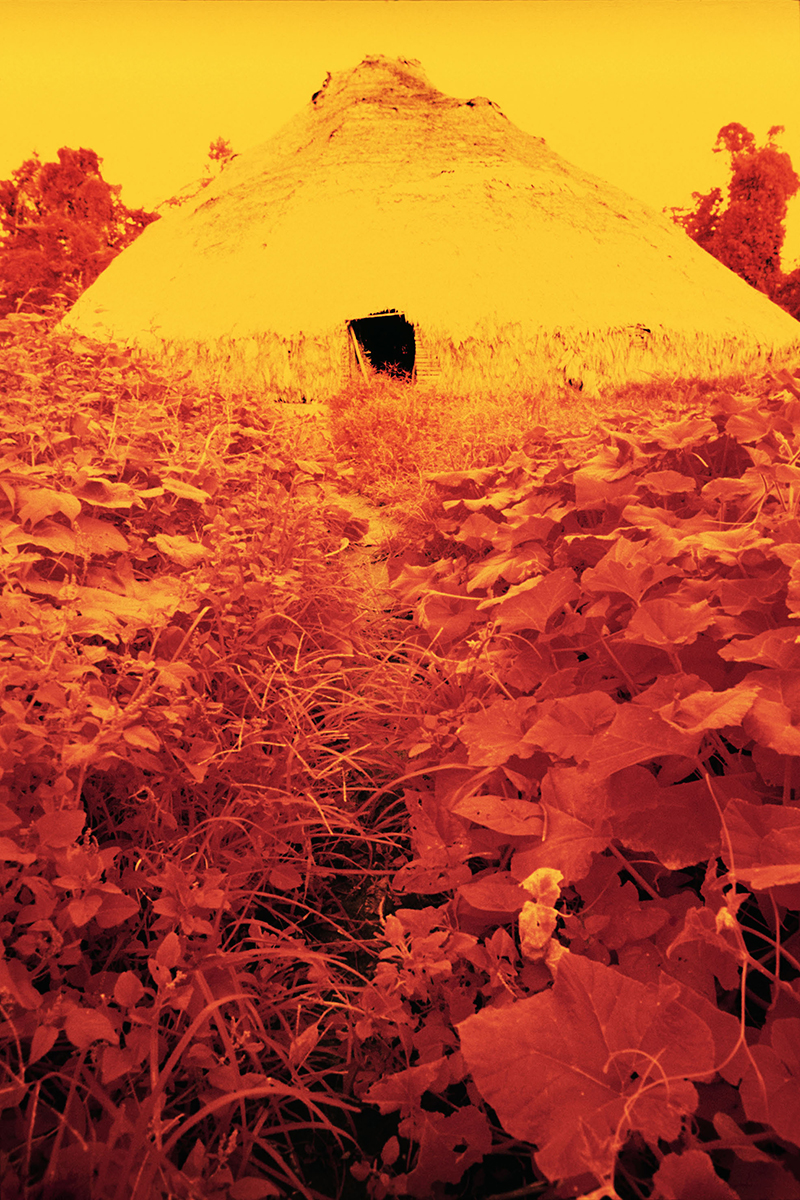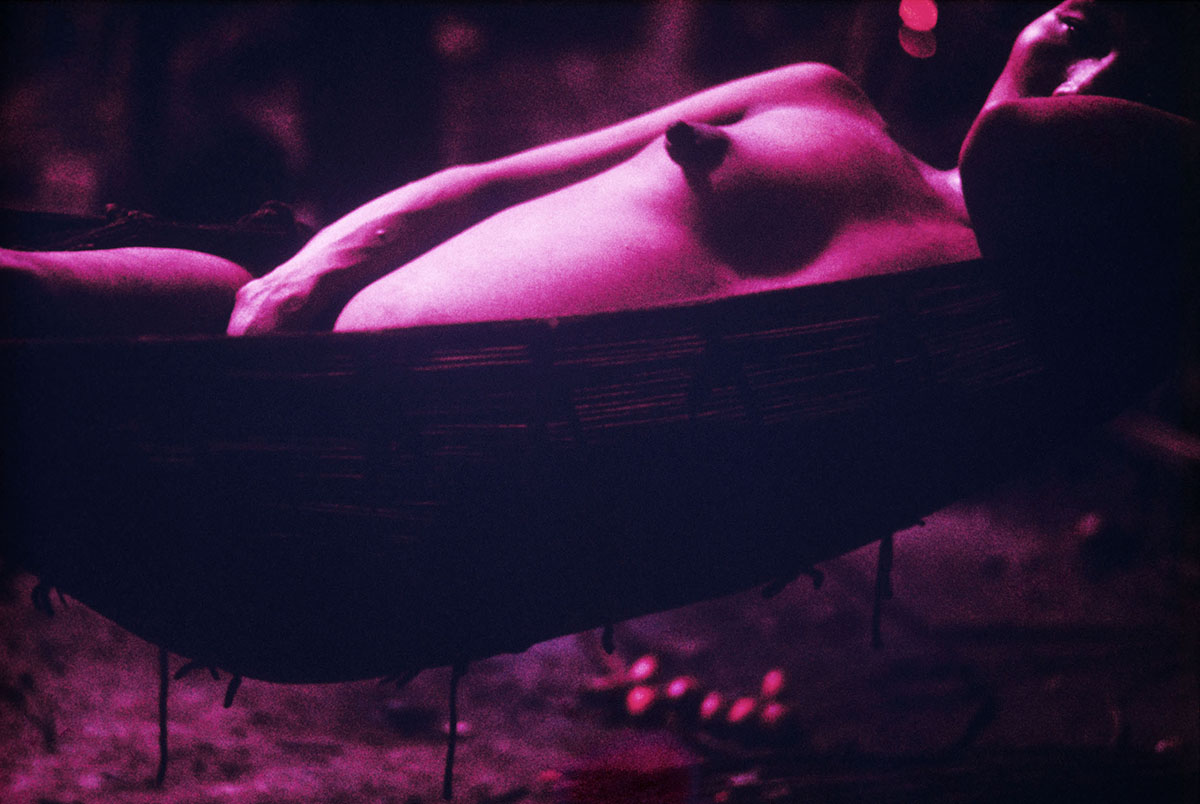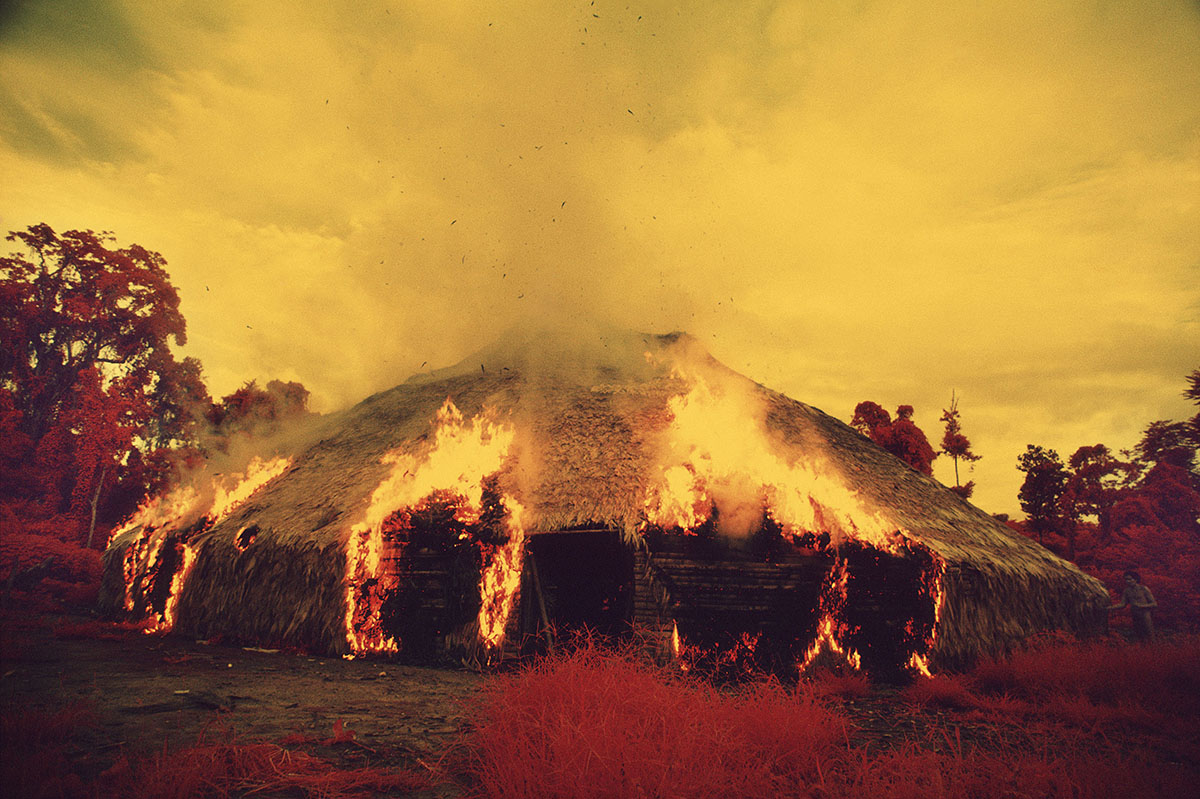Now on view at the Barbican, the Brazil-based artist-activist’s recent work documents the indigenous Yanomami of the Amazon and their fight for human rights
Call it lockdown-induced introspection, but sometimes it takes being shut out of the artworld (in this instance, the physical one, and the office from which this magazine is produced) in order to realise just how much that environment can narrow your understanding of visual culture. For example, here’s a writer with a specific interest in photography, for whom writing about it started to become about trying to prove the ways in which that medium is an art, within the pages of an art magazine – an absurdly reductive position to take. Ironically, sometimes it takes an exhibition to come along in order to knock those blinkers right off. To understand that what’s exciting about photography is precisely the fact that it cannot, in itself, be reduced to an artform.
In 1935 Walter Benjamin wrote of the rivalry between painting and photography in ‘The Work of Art in the Age of Mechanical Reproduction’, an essay describing the advent of photography as the first revolutionary means of reproduction at a moment of crisis for ‘traditional’ arts: ‘When the age of mechanical reproduction separated art from its basis in cult, the semblance of its autonomy disappeared forever.’ It seems that the artworld’s response to this crisis was to absorb the medium by, as American academic and curator Marvin Heiferman observes in his 2012 publication Photography Changes Everything, developing a discourse on photographs that has largely been centred around those made as art, and those that were elevated to the status of art. But, Heiferman writes, ‘While the championing of photography as art by photographers, galleries, art museum photography departments, art historians, and MFA programs, has helped foster serious consideration of the medium, it has also created something of a roadblock.’ That is, the value of photography has become dependent on whether it is received as an artform, and not, as it should be, for the much broader cultural role it plays in changing the way society perceives and operates in the world.

Where amid all this does the work of Swiss-born Brazilian activist and photographer Claudia Andujar fall? Following a traumatic childhood that included fleeing from Hungary to Switzerland in 1944, when her father and other family members were killed at Auschwitz and Dachau, Andujar moved to New York and then São Paulo, where she began her career as a photographer. She made her first series of work, photographing the indigenous Karajá people from the Rio Araguaia, in 1956, published photographs in art and culture magazines such as Life, A Cigarra, Jubilee, Esquire and Realidade, and, although making a conscious decision to turn her artistic career towards activism, has nevertheless exhibited work at art institutions and galleries internationally since 1960. For almost seven decades, Andujar’s photographs, extensively of indigenous peoples, have slipped between the genres of documentary, anthropology, activism and art.

The latest exhibition of her photographs, documenting the indigenous Yanomami of the Amazon and their fight for human rights, first opened in early 2018 at Instituto Moreira Salles’s outpost in São Paulo, before travelling to its main location in Rio de Janeiro in 2019 and then to the Fondation Cartier in Paris in 2020 (with plans to travel to Winterthur, Milan and Barcelona). It includes over 300 photographs, an audiovisual installation (first presented in 1989 and reproduced for this show) and collaborative drawings made between 1971 and 1989 during several of her visits to the community. Located across the ground and basement levels of the foundation, the exhibition follows her work chronologically – beginning with a series of photographs of the Yanomami community based in Catrimani, Roraima state.
Originally published in Brazilian magazine Realidade in 1971 (and later in the newspaper Ex-14 in 1975) for a self-assigned photojournalistic project on the Amazon rainforest, they include images made with various techniques, such as the use of infrared, multiple exposure, reduced shutter-speed and Vaseline-smeared lenses in order to achieve a representation of her understanding of the indigenous people’s cosmological worldview – one that stems from an unseen realm of spirits, accessed only by shamans and through community rituals during, for example, reahu funerary feasts. Showing these photographs to the community functioned as a tool of communication that allowed her to build a relationship with the Yanomami; culturally, they do not make images of themselves for fear that leaving part of their earthly bodies behind after death will disrupt the cosmological order, yet they agreed to the publication of Andujar’s photographs on the understanding that these would help build awareness of their culture and aid the campaign against the destruction of their people and lands.

In a series of black-and-white and infrared photographs made in 1974, Andujar depicts the Korihana thëri, one of many Yanomami communities, engaged in a reahu ceremony as hosts to the Xaxanapi thëri, dancing, feasting, drinking plantain soup and breathing in yakoana-tree powder. This powder is considered to be the food of the xapiri, ancestral spirits that protect the Yanomami land and who share ancient knowledge with the communities’ shamans via the ingestion of it. Multiple long-exposures in the photographs render the scenes dreamlike. In one particularly dazzling image two men brandish weapons while streaks of light cluster above them in a manner that evokes shaman and Yanomami spokesperson Davi Kopewana’s description of the xapiri in The Falling Sky (2013): ‘A path of light opened before my eyes and unknown beings came towards me… They approached with slow movements, in a blinding light, waving young hoko si palm leaves.’

In a sense, then, these photos, and those in Andujar’s other series, simultaneously behave as documentation of a people and a culture, but also leave space for interpretation, recalling oft-cited theorist Roland Barthes’s ‘photographic paradox’. In his 1961 essay ‘The Photographic Message’, the Frenchman describes this situation as ‘the co-existence of two messages, the one without the code (the photographic analogue), the other with the code (the ‘art’, or the treatment, or the ‘writing’, or the rhetoric, of the photograph)’. This, he posits, results in an ethical paradox through which photojournalism seeks to document reality as closely and impartially as possible, in a manner that is ‘against the investment of values’, while the dissemination and reception of these images inevitably involves interpretation.
Andujar’s photographs of the Yanomami are a unique example of such an overlap, driven by the photographer’s intent to reflect her understanding of her subjects’ worldview as well as the subjects themselves. Moreover, her photographs are socially invested in the campaign for Yanomami rights (and therefore staged so as to elicit emotional investment from the viewer), which in turn becomes an alternative entry point (beyond the ‘objective’ record) for both the viewer and the institution that shows them.

The exhibition itself, split into two distinct halves, moves from photographs that invite the visitors to take a glimpse at Yanomami life through images of community hunts, celebrations and people bathing, sleeping, cooking and playing together, in which we might recognise moments of our own lives, to those with a sobering tone in the basement gallery that mark Andujar’s decision to depart from her career as an artist and instead dedicate herself to campaigning for the protection of Yanomami culture and lands. The building of the Trans-Amazonian highway and Perimetral Norte highway, set in motion by Brazil’s federal government in 1972 and 1973 respectively (the latter was abandoned three years later), as well as the discovery of gold, uranium and cassiterite, brought miners and migrant workers to the region. The subsequent introduction of diseases and viruses devastated the populations of indigenous communities – a threat that is now being repeated since the first COVID-19-related Yanomami death was reported in April, suspected to have been transmitted by illegal goldminers who have invaded the Yanomami reserve.

A wall bisects the basement gallery. On one side, a series of black- and-white portraits taken between 1974 and 1976 form a grid across the perimeter. They are closeup and intimate, revealing moments such as a mother cradling her baby, a small child with closed eyes, a girl’s lips being pierced with a palm splinter during a rite of passage marking puberty or the midsection of a man’s face, in deep contrast so that one half is entirely cast in shadow. His visible eye looks directly into the lens. Opposite these hang a series of drawings made with colour pencils by the Yanomami, developed between 1976 and 1978, and depicting mythological stories. There’s a sense here that Andujar is creating methods of communication, not only during her experience with the Yanomami (later, during a phone call, she explains, “For them to draw with paper and coloured pencils was very new, but it was a way of trying to see if we would understand each other. It wasn’t just art. To have them draw was a language”) but also with the exhibition visitors. The works invite the visitors to develop an empathic connection with the Yanomami via photographs of the participants that accompany their drawings. The participants included seventeen-year-old Naki uxima, whose five drawings made in 1977 depict Omama (creator of life) and his twin brother, Yoasi (creator of sickness and death), two images of beliefs and practices related to menstruation, a poisonous plant used to make curare for arrowheads and an image of temporary shelters used during hunts. In the profile portrait of Naki uxima, against a background of dense shadow, he turns his face towards the light, eyes closed. That same year, Naki uxima died from measles, and the Brazilian government expelled Andujar from the Yanomami territory.
During her exile in São Paulo, along with missionary Carlo Zacquini and anthropologist Bruce Albert, Andujar cofounded the NGO Comissão Pró-Yanomami (CCPY, 1978), with which she embarked on an international campaign (joining with human rights organisation Survival International) to demarcate a continuous stretch of protected Yanomami lands. Her photographs accompanied pamphlets, reports and manifestos that were sent to international government agencies, the United Nations and the World Bank. It would take 14 years of campaigning before the Brazilian government would agree to a protected Yanomami territory, on the eve of the UN Conference on Environment and Development (also known as the Earth Summit), in 1992.

The other side of the dividing wall in the basement shows a collection of photos documenting the social effects of increased contact with the Yanomami – which, as well as introducing disease, delivered substance abuse and addiction, and violent conflicts – and a series of photographs taken during the 1980s when the CCPY initiated a vaccination programme (as part of a wider healthcare project) to help inoculate the Yanomami against the epidemics decimating their communities. Used as ID for the doctors’ medical records, Andujar’s photos could easily fit into her portrait series, were it not for the fact that each sitter is distinguished by a number assigned to them. Hung in grids according to different communities, it’s not hard to make the uncomfortable comparison between Andujar’s personal family history at the hands of Nazis, the numbering of the Yanomami and the threat to their lives – but this, in the same way as the earlier, colourful images on the ground floor, serves as an access point for the viewer, using an acutely meaningful visual language.

In an adjoining room, the audiovisual installation Genocidio do Yanomami: morte do Brasil (1989/2018) acts as a coda to the exhibition. First presented at MASP, São Paulo, the work was produced in response to the ongoing conflict, massacres, epidemics and environmental damage caused by invading miners and farmers. Originally a protest against the genocide of the Yanomami and the government’s plan to split the territory into 19 isolated areas, the 2018 iteration of Genocidio do Yanomami, accompanied by a soundtrack sung by indigenous Brazilian singer Marlui Miranda, is shown on 12 columnlike screens arranged in a semicircle and flashes with images taken from across her
series, culminating with the ID photos accompanied by newspaper clippings of the words ‘marcados para morrer’: marked to die.
In an age in which it seems like the social value of art is increasingly tethered to the extent to which it is considered ‘activist’, it’s arguable that the work of photographers like Claudia Andujar serves to elevate art and its Western institutions from a passive position (one that observes, reflects, comments on life) to an active participant in the discussion of ‘real’ global issues. Where once the debate was about photography’s legitimisation as an artform, now it is about the ways in which photography can be deployed to suggest that art institutions can be agents of change and in this sense ‘relevant’. There’s no doubt that, now, when Brazil’s current president is encouraging the destruction of the Amazon and its indigenous communities for profits in minerals, logging and farming (in the first four months of 2020, 1,202 square kilometres of the Amazon were razed) within protected territories, the increased visibility of Andujar’s work might be considered one of great salience. And displaying it within an art context is, simply, a means to an end. A travelling exhibition will help with that, but that the photographs shown in this context will achieve similar results as they did in aiding her work campaigning directly with the CCPY, Survival International and the United Nations remains to be seen. As Susan Sontag wrote in On Photography (1977): ‘Although the activities of some photographers conform to the traditional notion of a fine art… from the beginning photography has also lent itself to that notion of art which says that art is obsolete.’ At their most potent, Andujar’s photographs go way beyond ‘art’ and the endorsements of its institutions.
Claudia Andujar, The Yanomami Struggle is on view at The Barbican, London, until 29 August 2021
It was previously on view at The Fondation Cartier, Paris, 30 January – 13 September 2020
